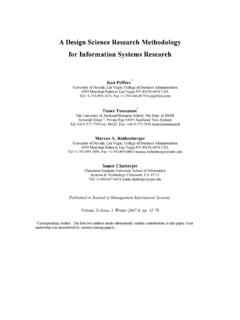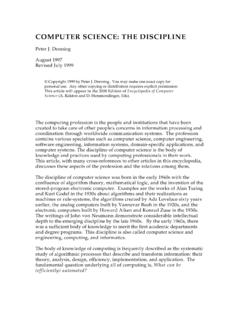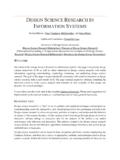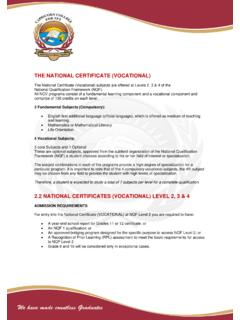Transcription of Computer System Validation - It’s More Than Just Testing
1 Page 1 of 10 Computer System Validation - It s More Than Just Testing Introduction Computer System Validation is the technical discipline that Life Science companies use to ensure that each Information Technology application fulfills its intended purpose. Stringent quality requirements in FDA regulated industries impose the need for specific controls and procedures throughout the Software Development Life Cycle (SDLC). Evidence that these controls and procedures have been followed and that they have resulted in quality software (software that satisfies its requirements) must be documented correctly and completely. These documents must be capable of standing up to close scrutiny by trained inspectors since the financial penalty for failing an audit can be extremely high.
2 More importantly, a problem in a Life Science software application that affects the production environment could result in serious adverse consequences, including possible loss of life. The activities involved in applying the appropriate controls/procedures throughout the SDLC and for creating the necessary trail of documented evidence are all part of the technical discipline of Computer System Validation . As we will discuss in this article, software Testing is a key component in this discipline. However, Computer System Validation , involves more than what many IT people consider to be software Testing . What is Computer System Validation and Why is it Important? A key source document providing FDA guidance on the general topic of Validation is General Principles of Validation , Food and Drug Administration from the Center for Drug Evaluation and Research.
3 [1]. The definition of Validation in this document is: Establishing documented evidence which provides a high degree of assurance that a specific process will consistently produce a product meeting its predetermined specification and quality attributes. Validation , as described in this document, is aimed at manufacturers of pharmaceuticals and medical devices who must demonstrate that their processes produce consistent product quality. It applies to all processes that fall under FDA regulation, including, but not limited to, Computer systems. For example, Validation applies to pharmaceutical manufacturing processes which include checking, cleaning, and documenting that all equipment used in manufacturing operates according to predetermined specifications.
4 Computer System Validation (or Computerized System Validation as it sometimes called in the literature) is the result of applying the above definition to a Computer System : Establishing documented evidence which provides a high degree of assurance that a Computer System will consistently produce results that meet its predetermined specification and quality attributes. Page 2 of 10 Note that a Computer System in the Life sciences sector is more than Computer hardware and software. It also includes the equipment and instruments linked to the System (if any) as well as the trained staff that operate the System and/or equipment using Standard Operating Procedures (SOPs) and manuals.
5 As applied to Computer systems, the FDA definition of Validation is an umbrella term that is broader than the way the term Validation is commonly used in the IT industry. In the IT industry, Validation usually refers to performing tests of software against its requirements [2]. A related term in the IT world is verification, which usually refers to Inspections, Walkthroughs, and other reviews and activities aimed at ensuring that the results of successive steps in the software development cycle correctly embrace the intentions of the previous step [3, 4]. As we will see below, FDA Validation of Computer systems includes all of these activities with a key focus on producing documented evidence that will be readily available for inspection by the FDA.
6 So Testing in the sense of executing the software is only one of multiple techniques used in Computer System Validation . There are two key reasons why Computer System Validation is extremely important in the Life Science sector: 1. Systematic Computer System Validation helps prevent software problems from reaching production environments. As previously mentioned, a problem in a Life Science software application that affects the production environment can result in serious adverse consequences. Besides the obvious humanistic reasons that the Life Science sector strives to prevent such harm to people, the business consequences of a software failure affecting people adversely can include lawsuits, financial penalties and manufacturing facilities getting shut down.
7 The ultimate result could be officers getting indicted, the company suffering economic instabilities, staff downsizing, and possibly eventual bankruptcy. 2. FDA regulations mandate the need to perform Computer System Validation and these regulations have the impact of law. Failing an FDA audit can result in FDA inspectional observations ( 483s ) and warning letters. Failure to take corrective action in a timely manner can result in shutting down manufacturing facilities, consent decrees, and stiff financial penalties. Again, the ultimate result could be loss of jobs, indictment of responsible parties (usually the officers of a company), and companies suffering economic instabilities resulting in downsizing and possibly eventual bankruptcy.
8 A key point to be gleaned from 1 and 2 above is that not only do FDA regulated companies need to do Computer System Validation , but they need to do it right. Cutting corners on doing a Validation might save a little money in the short term but these savings will look minute and inconsequential when compared to the potential costs and impacts of not doing the Validation correctly. Relationship of Computer System Validation to the Software Development Life Cycle1 Computer System Validation is carried out through activities that occur throughout the entire Software Development Life Cycle (SDLC). The V Diagram (Figure 1) is widely used in the IT 1 This section of the article draws freely from material that will appear in a new book by the author [5].
9 Page 3 of 10 literature to emphasize the importance of Testing and Testing related activities at every step in the SDLC. The V-diagram is really a recasting of the oft-criticized Waterfall model of the SDLC. In fact the phases in the Waterfall Model are essentially the life cycle phases that appear on the left-hand side of the V-diagram. The V-diagram emphasizes the need for various forms of Testing to be part of every step along the way. This avoids a big-bang Testing effort at the very end of the process, which has been one of the main criticisms associated with the Waterfall model (or the way some have people have interpreted the Waterfall model). The activities represented in the V-Diagram (labeled V &V in Figure 1) include Static Testing as well as Dynamic Testing activities.
10 Static Testing (sometimes called Static Analysis) refers to inspections, walkthroughs, and other review/analysis activities that can be performed without actually executing the software. In Dynamic Testing , the software is actually executed and compared against expected results. While many IT people use the term Testing to mean dynamic Testing , both dynamic and static Testing activities are used in Computer System Validation to help ensure that the results of successive steps in the SDLC correctly fulfill the intentions of the previous step [4]. Different types of activities represented in the V-Diagram are sometimes distinguished by the terms Verification and Validation , words whose connotations in the IT world were discussed in the previous section.







